PACC6007 Microeconomics Assignment: Demand, Supply, Cost & Elasticity
VerifiedAdded on 2024/05/20
|14
|1639
|234
Homework Assignment
AI Summary
This assignment solution delves into fundamental microeconomic concepts, examining demand, supply, and their related factors. It differentiates between changes in demand and changes in quantity demanded, alongside analyzing the impact of overseas companies and social trends on market dynamics. The assignment further explores price elasticity, its determinants, and provides calculations for elasticity coefficients. Additionally, it includes a detailed cost analysis, presenting total fixed cost, total variable cost, total cost, marginal cost, average fixed cost, average variable cost, and average total costs, accompanied by graphical representations of average variable cost, average total cost, and marginal cost curves. Desklib offers a wide array of solved assignments and past papers to aid students in their academic pursuits.
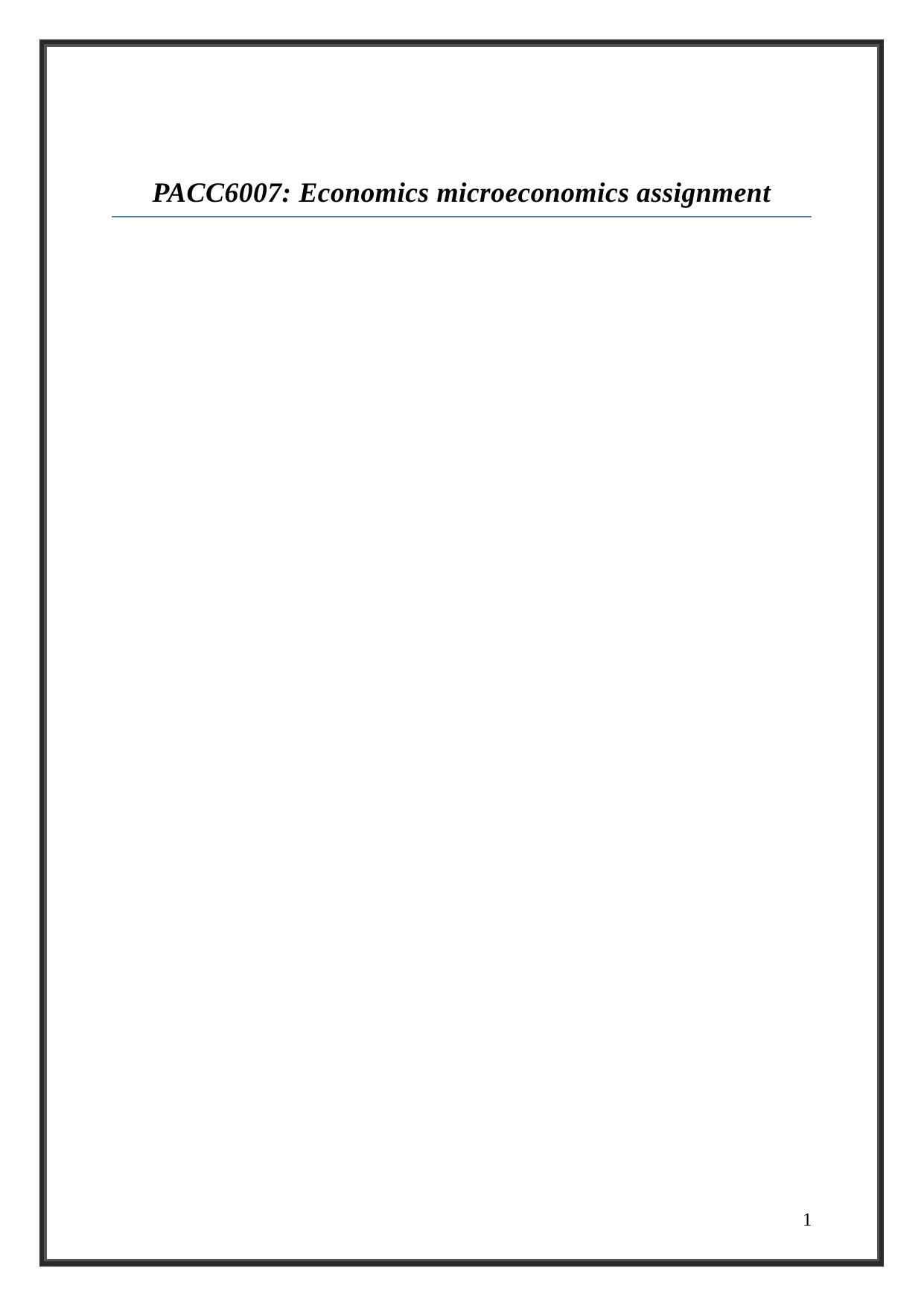
PACC6007: Economics microeconomics assignment
1
1
Paraphrase This Document
Need a fresh take? Get an instant paraphrase of this document with our AI Paraphraser
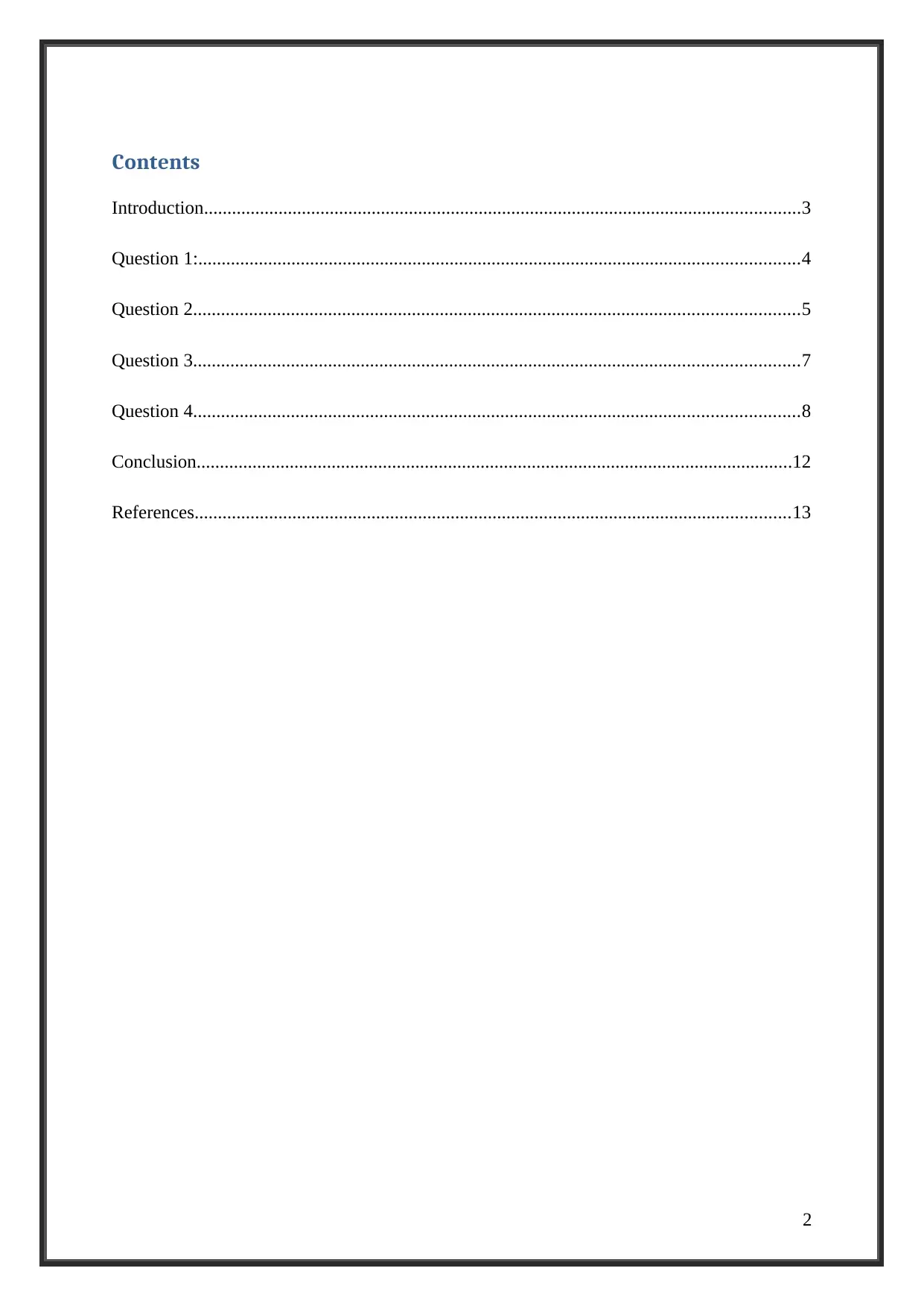
Contents
Introduction................................................................................................................................3
Question 1:.................................................................................................................................4
Question 2..................................................................................................................................5
Question 3..................................................................................................................................7
Question 4..................................................................................................................................8
Conclusion................................................................................................................................12
References................................................................................................................................13
2
Introduction................................................................................................................................3
Question 1:.................................................................................................................................4
Question 2..................................................................................................................................5
Question 3..................................................................................................................................7
Question 4..................................................................................................................................8
Conclusion................................................................................................................................12
References................................................................................................................................13
2
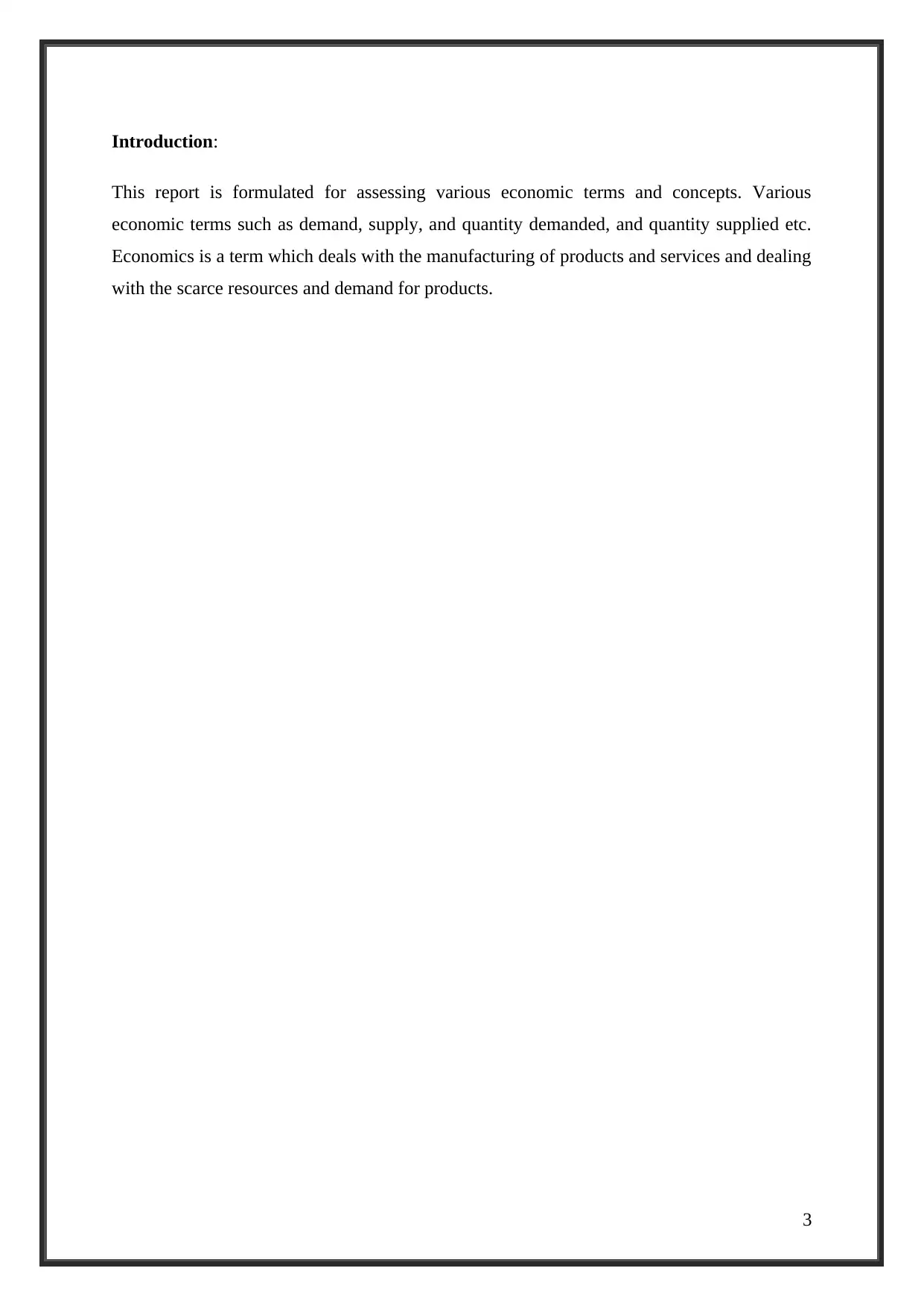
Introduction:
This report is formulated for assessing various economic terms and concepts. Various
economic terms such as demand, supply, and quantity demanded, and quantity supplied etc.
Economics is a term which deals with the manufacturing of products and services and dealing
with the scarce resources and demand for products.
3
This report is formulated for assessing various economic terms and concepts. Various
economic terms such as demand, supply, and quantity demanded, and quantity supplied etc.
Economics is a term which deals with the manufacturing of products and services and dealing
with the scarce resources and demand for products.
3
⊘ This is a preview!⊘
Do you want full access?
Subscribe today to unlock all pages.

Trusted by 1+ million students worldwide
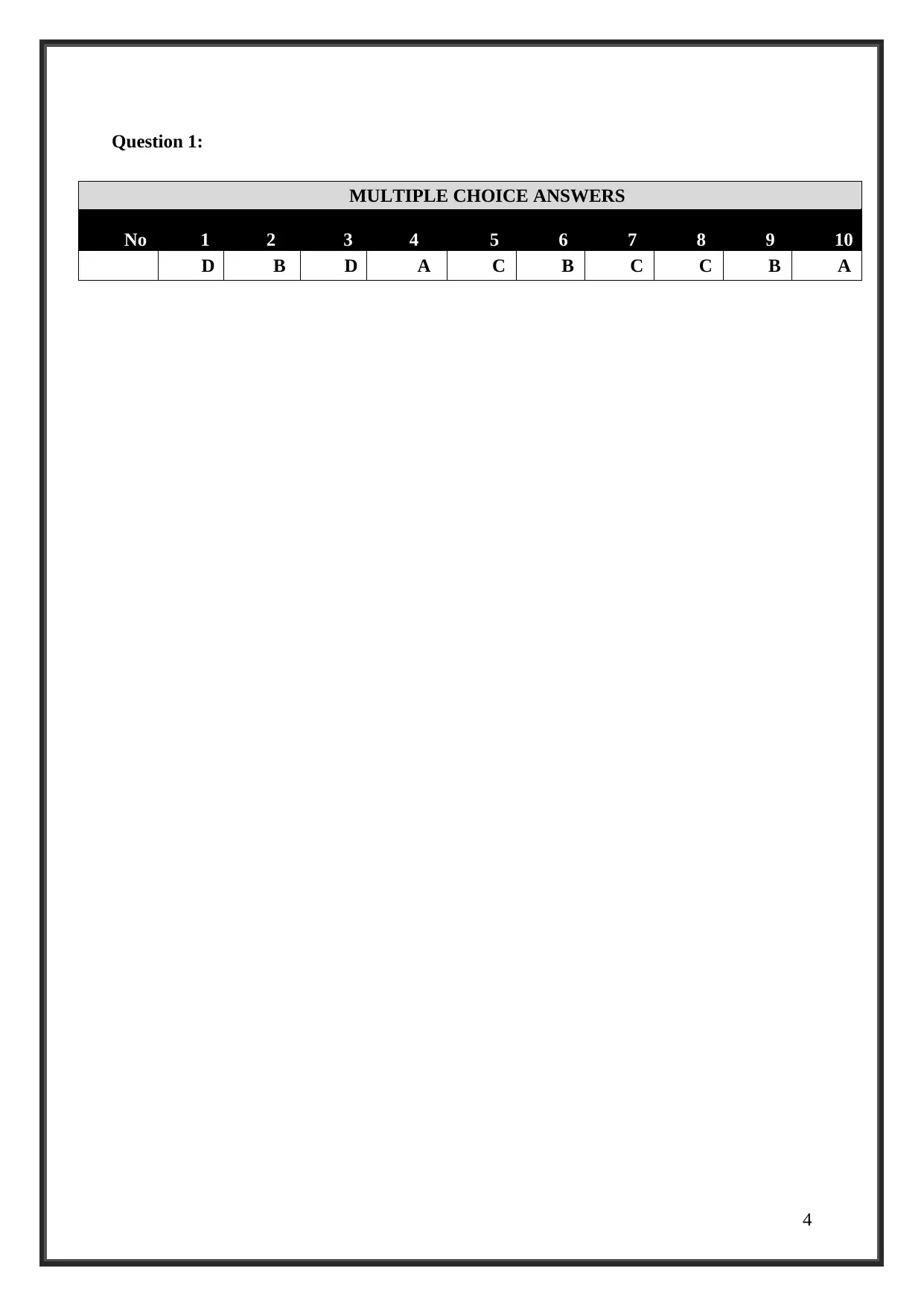
Question 1:
MULTIPLE CHOICE ANSWERS
No 1 2 3 4 5 6 7 8 9 10
D B D A C B C C B A
4
MULTIPLE CHOICE ANSWERS
No 1 2 3 4 5 6 7 8 9 10
D B D A C B C C B A
4
Paraphrase This Document
Need a fresh take? Get an instant paraphrase of this document with our AI Paraphraser
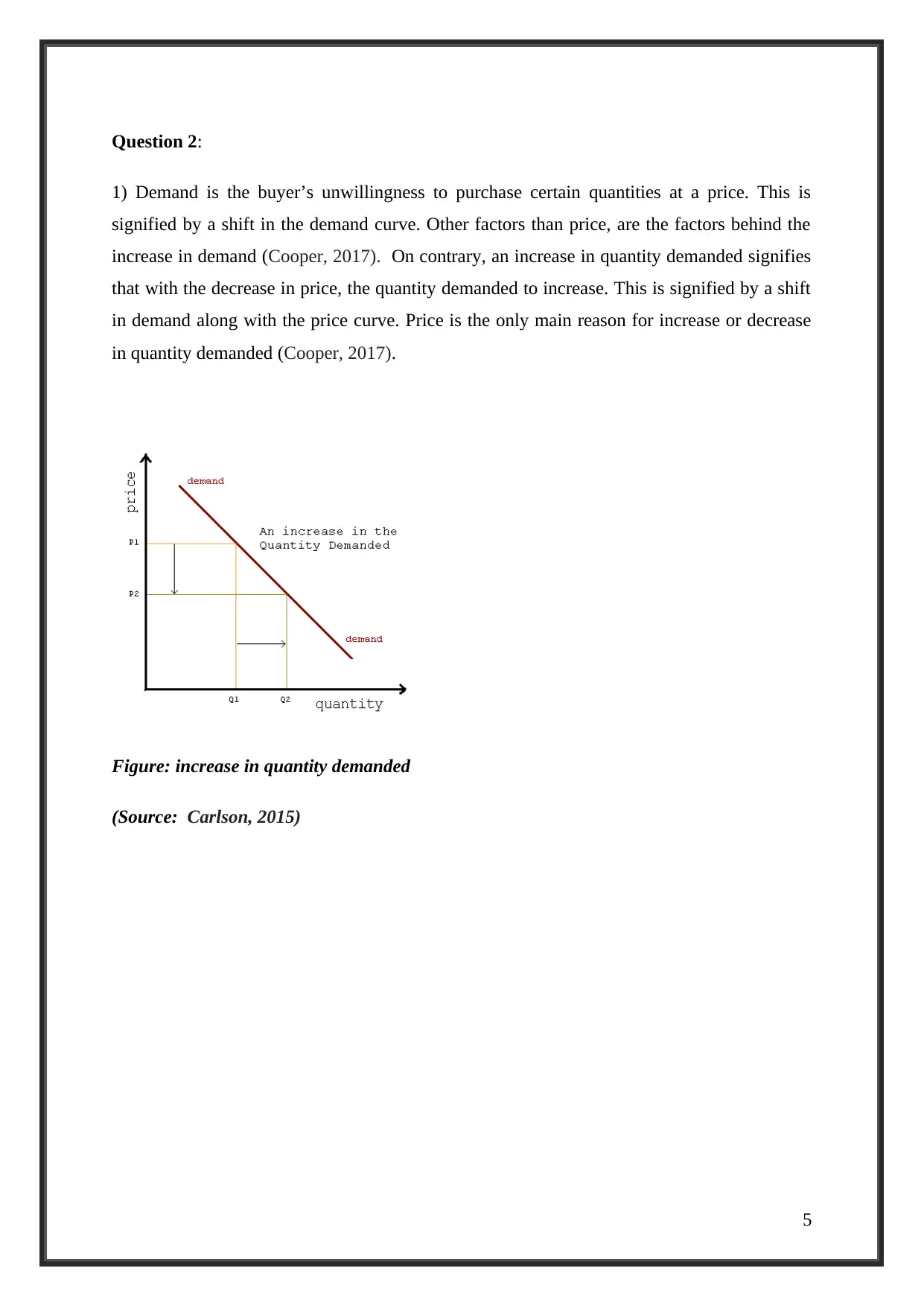
Question 2:
1) Demand is the buyer’s unwillingness to purchase certain quantities at a price. This is
signified by a shift in the demand curve. Other factors than price, are the factors behind the
increase in demand (Cooper, 2017). On contrary, an increase in quantity demanded signifies
that with the decrease in price, the quantity demanded to increase. This is signified by a shift
in demand along with the price curve. Price is the only main reason for increase or decrease
in quantity demanded (Cooper, 2017).
Figure: increase in quantity demanded
(Source: Carlson, 2015)
5
1) Demand is the buyer’s unwillingness to purchase certain quantities at a price. This is
signified by a shift in the demand curve. Other factors than price, are the factors behind the
increase in demand (Cooper, 2017). On contrary, an increase in quantity demanded signifies
that with the decrease in price, the quantity demanded to increase. This is signified by a shift
in demand along with the price curve. Price is the only main reason for increase or decrease
in quantity demanded (Cooper, 2017).
Figure: increase in quantity demanded
(Source: Carlson, 2015)
5
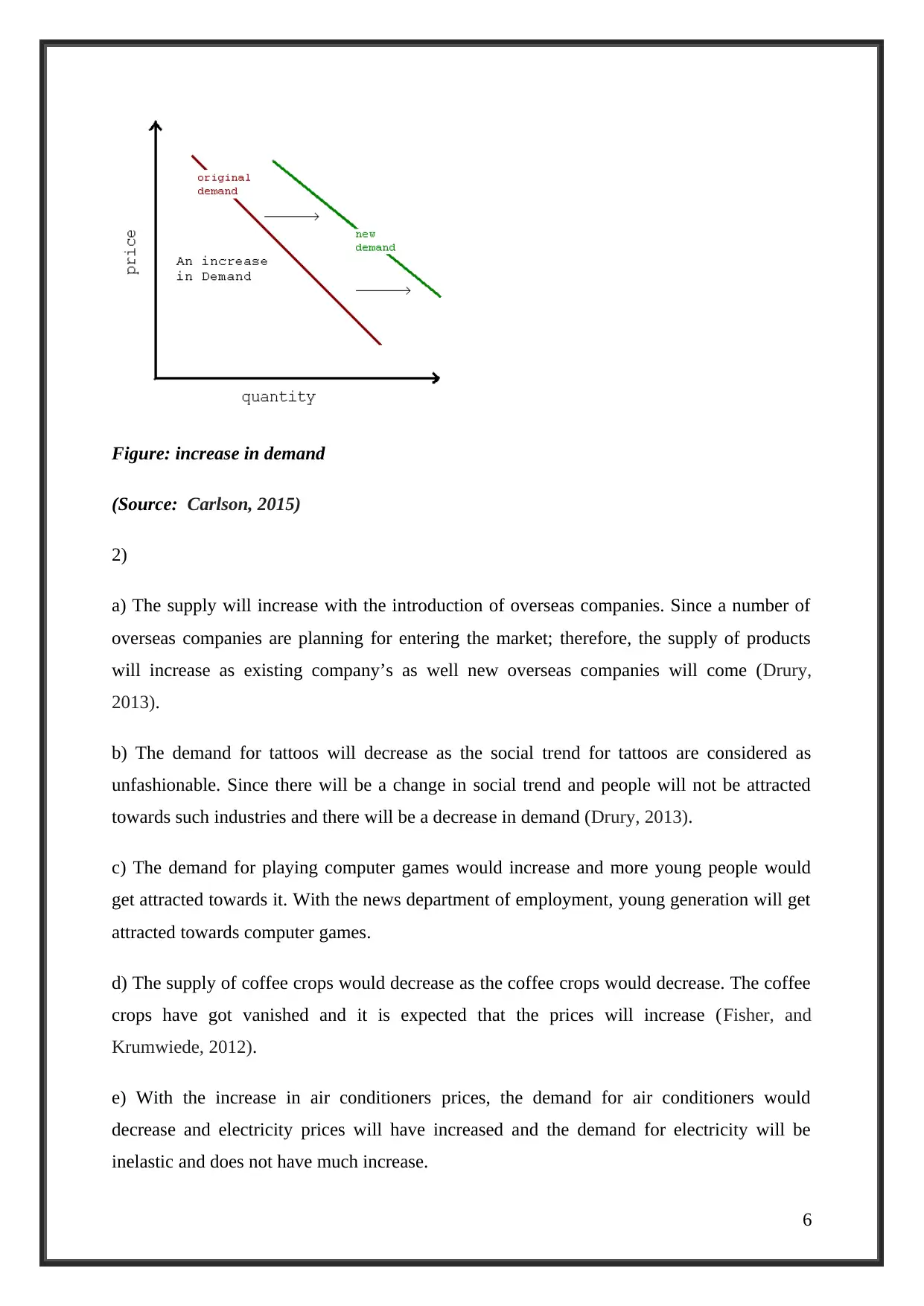
Figure: increase in demand
(Source: Carlson, 2015)
2)
a) The supply will increase with the introduction of overseas companies. Since a number of
overseas companies are planning for entering the market; therefore, the supply of products
will increase as existing company’s as well new overseas companies will come (Drury,
2013).
b) The demand for tattoos will decrease as the social trend for tattoos are considered as
unfashionable. Since there will be a change in social trend and people will not be attracted
towards such industries and there will be a decrease in demand (Drury, 2013).
c) The demand for playing computer games would increase and more young people would
get attracted towards it. With the news department of employment, young generation will get
attracted towards computer games.
d) The supply of coffee crops would decrease as the coffee crops would decrease. The coffee
crops have got vanished and it is expected that the prices will increase (Fisher, and
Krumwiede, 2012).
e) With the increase in air conditioners prices, the demand for air conditioners would
decrease and electricity prices will have increased and the demand for electricity will be
inelastic and does not have much increase.
6
(Source: Carlson, 2015)
2)
a) The supply will increase with the introduction of overseas companies. Since a number of
overseas companies are planning for entering the market; therefore, the supply of products
will increase as existing company’s as well new overseas companies will come (Drury,
2013).
b) The demand for tattoos will decrease as the social trend for tattoos are considered as
unfashionable. Since there will be a change in social trend and people will not be attracted
towards such industries and there will be a decrease in demand (Drury, 2013).
c) The demand for playing computer games would increase and more young people would
get attracted towards it. With the news department of employment, young generation will get
attracted towards computer games.
d) The supply of coffee crops would decrease as the coffee crops would decrease. The coffee
crops have got vanished and it is expected that the prices will increase (Fisher, and
Krumwiede, 2012).
e) With the increase in air conditioners prices, the demand for air conditioners would
decrease and electricity prices will have increased and the demand for electricity will be
inelastic and does not have much increase.
6
⊘ This is a preview!⊘
Do you want full access?
Subscribe today to unlock all pages.

Trusted by 1+ million students worldwide
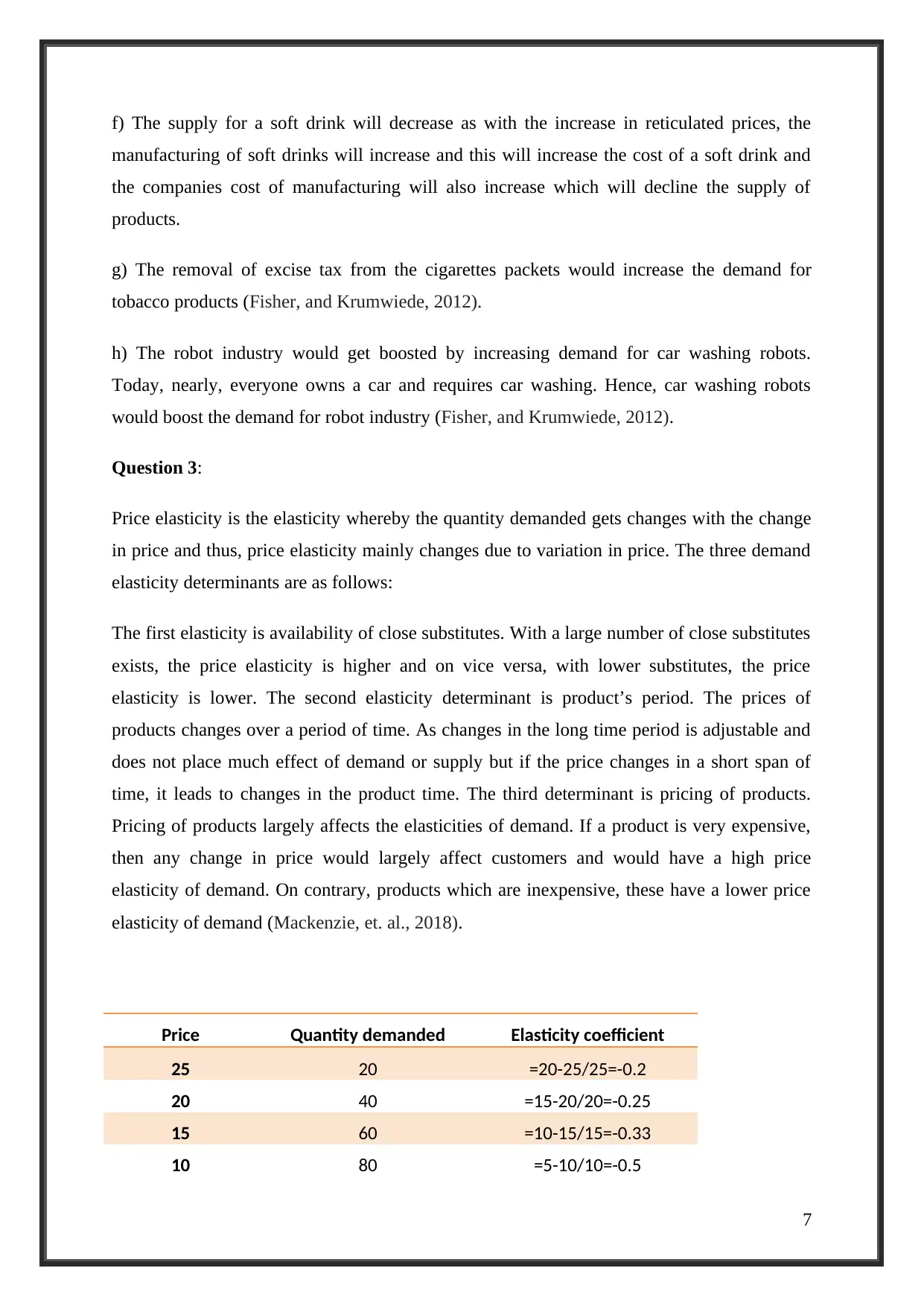
f) The supply for a soft drink will decrease as with the increase in reticulated prices, the
manufacturing of soft drinks will increase and this will increase the cost of a soft drink and
the companies cost of manufacturing will also increase which will decline the supply of
products.
g) The removal of excise tax from the cigarettes packets would increase the demand for
tobacco products (Fisher, and Krumwiede, 2012).
h) The robot industry would get boosted by increasing demand for car washing robots.
Today, nearly, everyone owns a car and requires car washing. Hence, car washing robots
would boost the demand for robot industry (Fisher, and Krumwiede, 2012).
Question 3:
Price elasticity is the elasticity whereby the quantity demanded gets changes with the change
in price and thus, price elasticity mainly changes due to variation in price. The three demand
elasticity determinants are as follows:
The first elasticity is availability of close substitutes. With a large number of close substitutes
exists, the price elasticity is higher and on vice versa, with lower substitutes, the price
elasticity is lower. The second elasticity determinant is product’s period. The prices of
products changes over a period of time. As changes in the long time period is adjustable and
does not place much effect of demand or supply but if the price changes in a short span of
time, it leads to changes in the product time. The third determinant is pricing of products.
Pricing of products largely affects the elasticities of demand. If a product is very expensive,
then any change in price would largely affect customers and would have a high price
elasticity of demand. On contrary, products which are inexpensive, these have a lower price
elasticity of demand (Mackenzie, et. al., 2018).
Price Quantity demanded Elasticity coefficient
25 20 =20-25/25=-0.2
20 40 =15-20/20=-0.25
15 60 =10-15/15=-0.33
10 80 =5-10/10=-0.5
7
manufacturing of soft drinks will increase and this will increase the cost of a soft drink and
the companies cost of manufacturing will also increase which will decline the supply of
products.
g) The removal of excise tax from the cigarettes packets would increase the demand for
tobacco products (Fisher, and Krumwiede, 2012).
h) The robot industry would get boosted by increasing demand for car washing robots.
Today, nearly, everyone owns a car and requires car washing. Hence, car washing robots
would boost the demand for robot industry (Fisher, and Krumwiede, 2012).
Question 3:
Price elasticity is the elasticity whereby the quantity demanded gets changes with the change
in price and thus, price elasticity mainly changes due to variation in price. The three demand
elasticity determinants are as follows:
The first elasticity is availability of close substitutes. With a large number of close substitutes
exists, the price elasticity is higher and on vice versa, with lower substitutes, the price
elasticity is lower. The second elasticity determinant is product’s period. The prices of
products changes over a period of time. As changes in the long time period is adjustable and
does not place much effect of demand or supply but if the price changes in a short span of
time, it leads to changes in the product time. The third determinant is pricing of products.
Pricing of products largely affects the elasticities of demand. If a product is very expensive,
then any change in price would largely affect customers and would have a high price
elasticity of demand. On contrary, products which are inexpensive, these have a lower price
elasticity of demand (Mackenzie, et. al., 2018).
Price Quantity demanded Elasticity coefficient
25 20 =20-25/25=-0.2
20 40 =15-20/20=-0.25
15 60 =10-15/15=-0.33
10 80 =5-10/10=-0.5
7
Paraphrase This Document
Need a fresh take? Get an instant paraphrase of this document with our AI Paraphraser
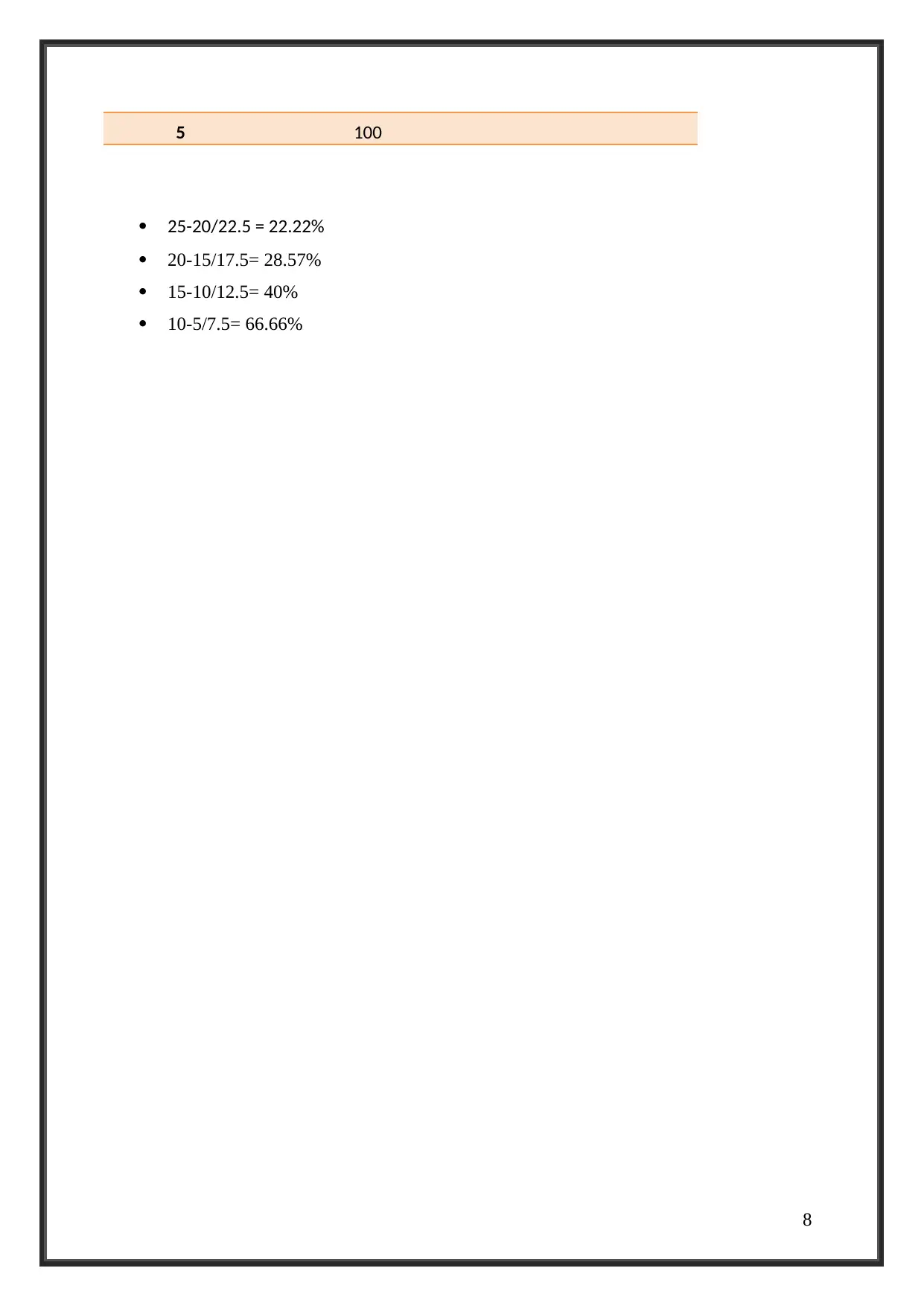
5 100
25-20/22.5 = 22.22%
20-15/17.5= 28.57%
15-10/12.5= 40%
10-5/7.5= 66.66%
8
25-20/22.5 = 22.22%
20-15/17.5= 28.57%
15-10/12.5= 40%
10-5/7.5= 66.66%
8
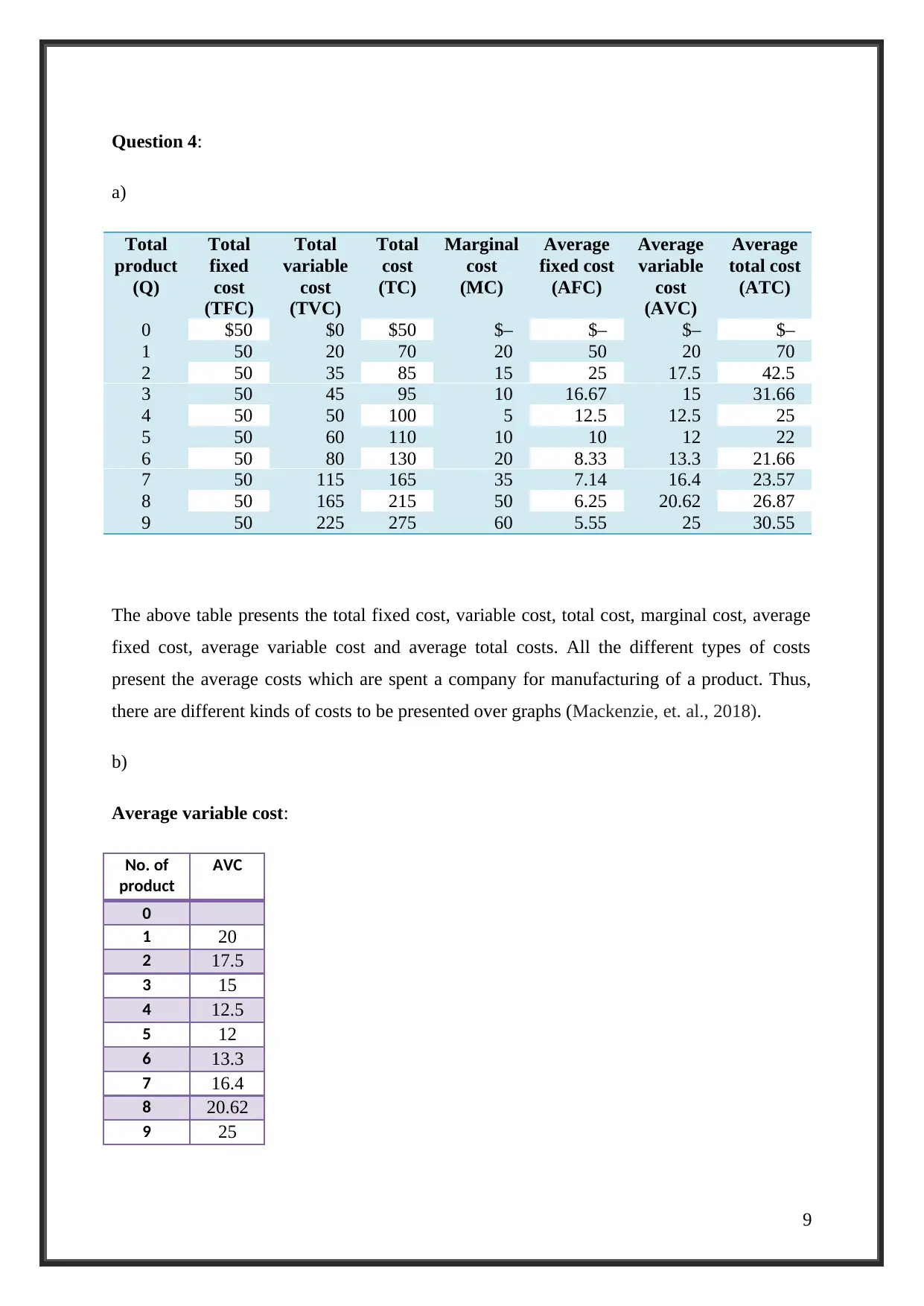
Question 4:
a)
Total
product
(Q)
Total
fixed
cost
(TFC)
Total
variable
cost
(TVC)
Total
cost
(TC)
Marginal
cost
(MC)
Average
fixed cost
(AFC)
Average
variable
cost
(AVC)
Average
total cost
(ATC)
0 $50 $0 $50 $– $– $– $–
1 50 20 70 20 50 20 70
2 50 35 85 15 25 17.5 42.5
3 50 45 95 10 16.67 15 31.66
4 50 50 100 5 12.5 12.5 25
5 50 60 110 10 10 12 22
6 50 80 130 20 8.33 13.3 21.66
7 50 115 165 35 7.14 16.4 23.57
8 50 165 215 50 6.25 20.62 26.87
9 50 225 275 60 5.55 25 30.55
The above table presents the total fixed cost, variable cost, total cost, marginal cost, average
fixed cost, average variable cost and average total costs. All the different types of costs
present the average costs which are spent a company for manufacturing of a product. Thus,
there are different kinds of costs to be presented over graphs (Mackenzie, et. al., 2018).
b)
Average variable cost:
No. of
product
AVC
0
1 20
2 17.5
3 15
4 12.5
5 12
6 13.3
7 16.4
8 20.62
9 25
9
a)
Total
product
(Q)
Total
fixed
cost
(TFC)
Total
variable
cost
(TVC)
Total
cost
(TC)
Marginal
cost
(MC)
Average
fixed cost
(AFC)
Average
variable
cost
(AVC)
Average
total cost
(ATC)
0 $50 $0 $50 $– $– $– $–
1 50 20 70 20 50 20 70
2 50 35 85 15 25 17.5 42.5
3 50 45 95 10 16.67 15 31.66
4 50 50 100 5 12.5 12.5 25
5 50 60 110 10 10 12 22
6 50 80 130 20 8.33 13.3 21.66
7 50 115 165 35 7.14 16.4 23.57
8 50 165 215 50 6.25 20.62 26.87
9 50 225 275 60 5.55 25 30.55
The above table presents the total fixed cost, variable cost, total cost, marginal cost, average
fixed cost, average variable cost and average total costs. All the different types of costs
present the average costs which are spent a company for manufacturing of a product. Thus,
there are different kinds of costs to be presented over graphs (Mackenzie, et. al., 2018).
b)
Average variable cost:
No. of
product
AVC
0
1 20
2 17.5
3 15
4 12.5
5 12
6 13.3
7 16.4
8 20.62
9 25
9
⊘ This is a preview!⊘
Do you want full access?
Subscribe today to unlock all pages.

Trusted by 1+ million students worldwide
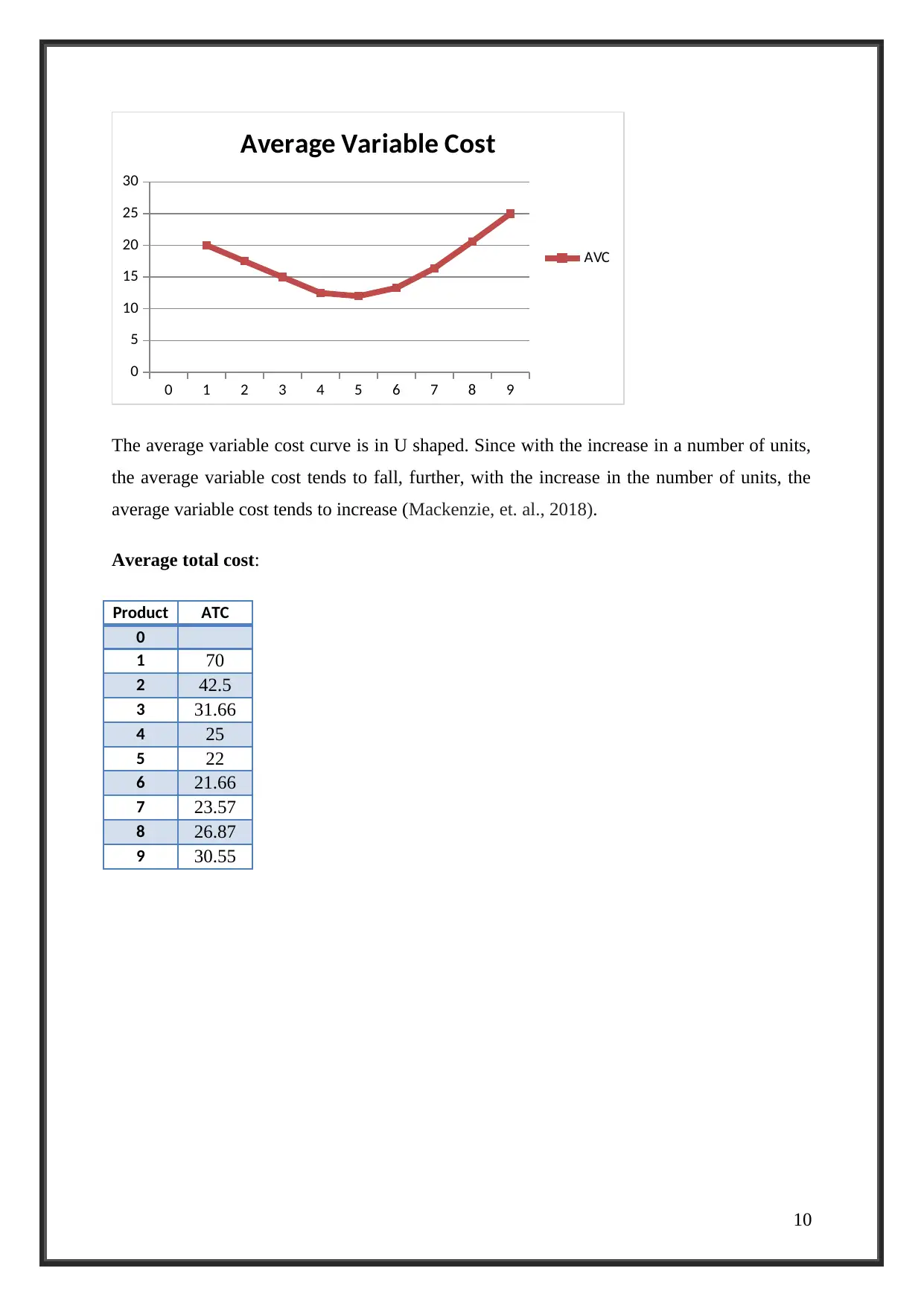
0 1 2 3 4 5 6 7 8 9
0
5
10
15
20
25
30
Average Variable Cost
AVC
The average variable cost curve is in U shaped. Since with the increase in a number of units,
the average variable cost tends to fall, further, with the increase in the number of units, the
average variable cost tends to increase (Mackenzie, et. al., 2018).
Average total cost:
Product ATC
0
1 70
2 42.5
3 31.66
4 25
5 22
6 21.66
7 23.57
8 26.87
9 30.55
10
0
5
10
15
20
25
30
Average Variable Cost
AVC
The average variable cost curve is in U shaped. Since with the increase in a number of units,
the average variable cost tends to fall, further, with the increase in the number of units, the
average variable cost tends to increase (Mackenzie, et. al., 2018).
Average total cost:
Product ATC
0
1 70
2 42.5
3 31.66
4 25
5 22
6 21.66
7 23.57
8 26.87
9 30.55
10
Paraphrase This Document
Need a fresh take? Get an instant paraphrase of this document with our AI Paraphraser
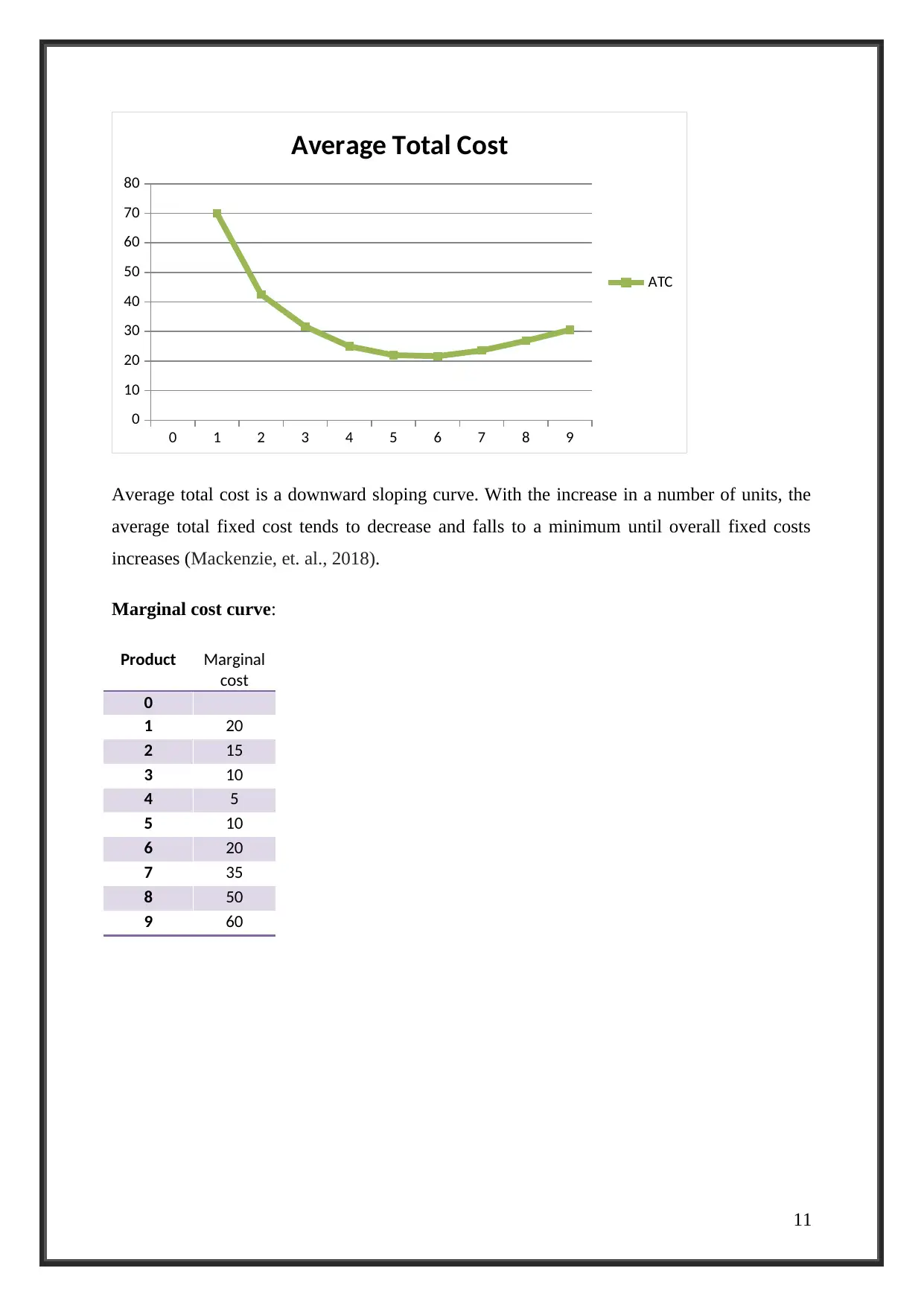
0 1 2 3 4 5 6 7 8 9
0
10
20
30
40
50
60
70
80
Average Total Cost
ATC
Average total cost is a downward sloping curve. With the increase in a number of units, the
average total fixed cost tends to decrease and falls to a minimum until overall fixed costs
increases (Mackenzie, et. al., 2018).
Marginal cost curve:
Product Marginal
cost
0
1 20
2 15
3 10
4 5
5 10
6 20
7 35
8 50
9 60
11
0
10
20
30
40
50
60
70
80
Average Total Cost
ATC
Average total cost is a downward sloping curve. With the increase in a number of units, the
average total fixed cost tends to decrease and falls to a minimum until overall fixed costs
increases (Mackenzie, et. al., 2018).
Marginal cost curve:
Product Marginal
cost
0
1 20
2 15
3 10
4 5
5 10
6 20
7 35
8 50
9 60
11
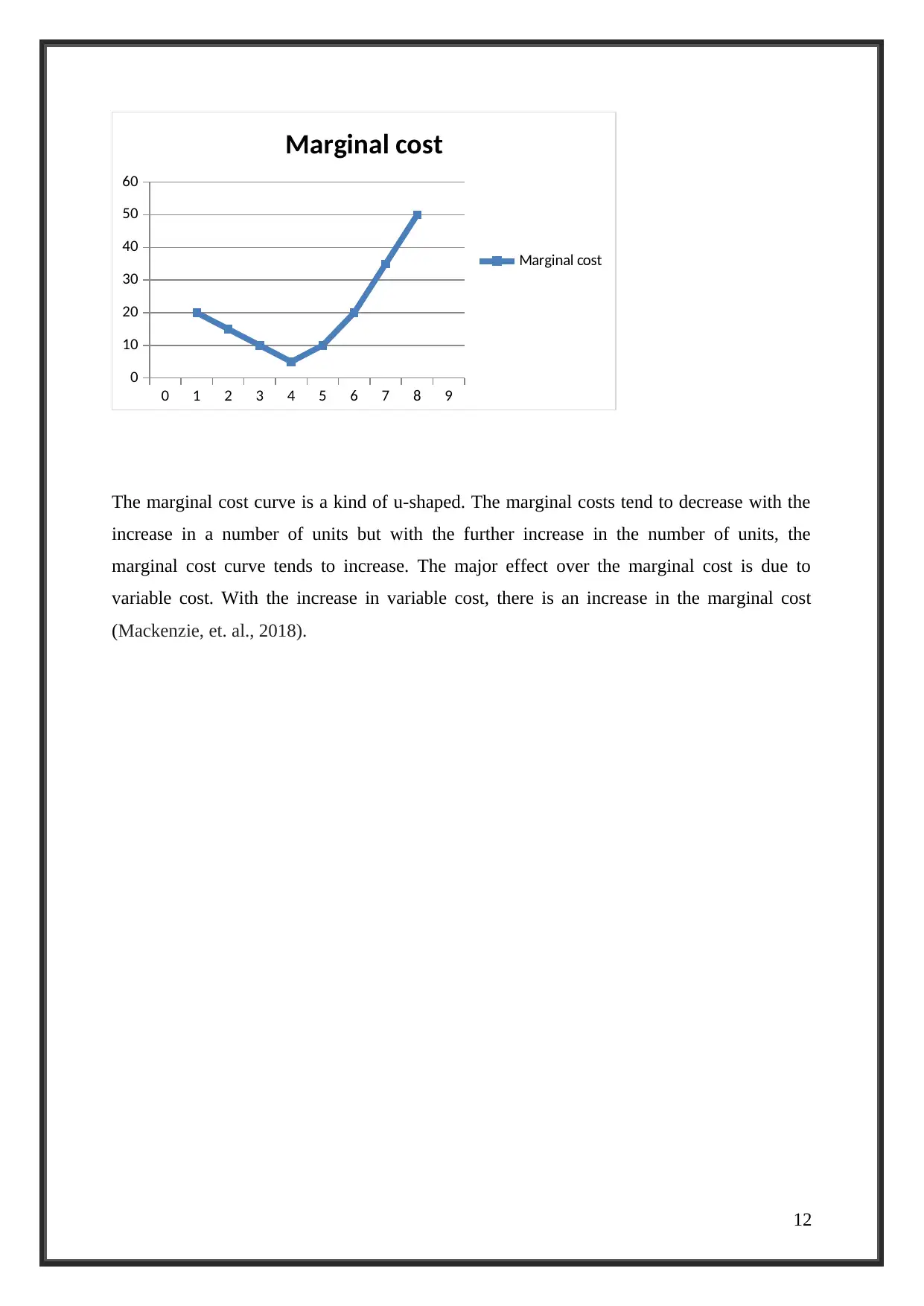
0 1 2 3 4 5 6 7 8 9
0
10
20
30
40
50
60
Marginal cost
Marginal cost
The marginal cost curve is a kind of u-shaped. The marginal costs tend to decrease with the
increase in a number of units but with the further increase in the number of units, the
marginal cost curve tends to increase. The major effect over the marginal cost is due to
variable cost. With the increase in variable cost, there is an increase in the marginal cost
(Mackenzie, et. al., 2018).
12
0
10
20
30
40
50
60
Marginal cost
Marginal cost
The marginal cost curve is a kind of u-shaped. The marginal costs tend to decrease with the
increase in a number of units but with the further increase in the number of units, the
marginal cost curve tends to increase. The major effect over the marginal cost is due to
variable cost. With the increase in variable cost, there is an increase in the marginal cost
(Mackenzie, et. al., 2018).
12
⊘ This is a preview!⊘
Do you want full access?
Subscribe today to unlock all pages.

Trusted by 1+ million students worldwide
1 out of 14
Your All-in-One AI-Powered Toolkit for Academic Success.
+13062052269
info@desklib.com
Available 24*7 on WhatsApp / Email
![[object Object]](/_next/static/media/star-bottom.7253800d.svg)
Unlock your academic potential
Copyright © 2020–2025 A2Z Services. All Rights Reserved. Developed and managed by ZUCOL.

